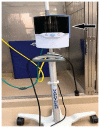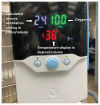Conventional versus high-flow oxygen therapy in dogs with lower airway injury
- PMID: 34602728
- PMCID: PMC8451709
Conventional versus high-flow oxygen therapy in dogs with lower airway injury
Abstract
Dogs with lower airway pathology that present in respiratory distress often receive oxygen therapy as the first line of treatment regardless of the underlying cause. Conventional "low-flow" systems deliver oxygen with a maximum flow rate of 15 L/minute. Traditionally, when an animal's respiratory status does not improve with conventional oxygen therapy and treatments for underlying disease, options might be limited to either intubation and mechanical ventilation or humane euthanasia. High-flow oxygen therapy (HFOT) has been gaining popularity in veterinary medicine as an alternative route of oxygen supplementation for animals that require support beyond conventional therapy. High-flow oxygen therapy can supply a mixture of air and oxygen via a heated and humidified circuit. It is user friendly and can be used in an environment in which mechanical ventilation is unavailable. This review article is written for emergency doctors and general practitioners who lack access to mechanical ventilation. This article briefly reviews pertinent respiratory physiology, traditional oxygen supplementation techniques, the physiology of HFOT, and the limited evidence available in veterinary medicine regarding the use of HFOT, its applications, and limitations. Guidelines for the use of HFOT are suggested and HFOT is compared to conventional therapy.
Les chiens avec une pathologie des voies respiratoires inférieures qui présentent une détresse respiratoire reçoivent souvent une oxygénothérapie en première intention, quelle que soit la cause sous-jacente. Les systèmes conventionnels à « faible débit » fournissent de l’oxygène avec un débit maximum de 15 L/minute. Traditionnellement, lorsque l’état respiratoire d’un animal ne s’améliore pas avec l’oxygénothérapie conventionnelle et les traitements de la maladie sous-jacente, les options peuvent se limiter à l’intubation et à la ventilation mécanique ou à l’euthanasie. L’oxygénothérapie à haut débit (HFOT) gagne en popularité en médecine vétérinaire en tant que voie alternative de supplémentation en oxygène pour les animaux qui nécessitent un soutien au-delà de la thérapie conventionnelle. L’oxygénothérapie à haut débit peut fournir un mélange d’air et d’oxygène via un circuit chauffé et humidifié. Il est convivial et peut être utilisé dans un environnement où la ventilation mécanique n’est pas disponible.Cet article de revue est écrit pour les médecins urgentistes et les médecins généralistes qui n’ont pas accès à la ventilation mécanique. L’article passe brièvement en revue la physiologie respiratoire pertinente, les techniques traditionnelles de supplémentation en oxygène, la physiologie de la HFOT et les preuves limitées disponibles en médecine vétérinaire concernant l’utilisation de la HFOT, ses applications et ses limites. Des lignes directrices pour l’utilisation de la HFOT sont suggérées et la HFOT est comparée au traitement conventionnel.(Traduit par Docteur Serge Messier).
Copyright and/or publishing rights held by the Canadian Veterinary Medical Association.
Figures





Similar articles
-
Proposed protocol for utilising high-flow nasal oxygen therapy in treatment of dogs hospitalised due to pneumonia.BMC Vet Res. 2023 Sep 21;19(1):167. doi: 10.1186/s12917-023-03737-7. BMC Vet Res. 2023. PMID: 37735404 Free PMC article.
-
Retrospective evaluation of the effect of high flow oxygen therapy delivered by nasal cannula on PaO2 in dogs with moderate-to-severe hypoxemia.J Vet Emerg Crit Care (San Antonio). 2016 Jul;26(4):598-602. doi: 10.1111/vec.12495. Epub 2016 Jun 22. J Vet Emerg Crit Care (San Antonio). 2016. PMID: 27333466
-
High-flow nasal cannula oxygen therapy in acute hypoxemic respiratory failure in 22 dogs requiring oxygen support escalation.J Vet Emerg Crit Care (San Antonio). 2020 Jul;30(4):364-375. doi: 10.1111/vec.12970. Epub 2020 Jun 24. J Vet Emerg Crit Care (San Antonio). 2020. PMID: 32583614
-
High-flow nasal cannula oxygen therapy in acute respiratory failure at Emergency Departments: A systematic review.Am J Emerg Med. 2020 Jul;38(7):1508-1514. doi: 10.1016/j.ajem.2020.04.091. Epub 2020 May 4. Am J Emerg Med. 2020. PMID: 32389397
-
A Review of High Flow Nasal Cannula Oxygen Therapy in Human and Veterinary Medicine.Top Companion Anim Med. 2022 Jan-Feb;46:100596. doi: 10.1016/j.tcam.2021.100596. Epub 2021 Oct 30. Top Companion Anim Med. 2022. PMID: 34757156 Review.
Cited by
-
Clinical review of high-flow nasal oxygen therapy in human and veterinary patients.Front Vet Sci. 2023 Mar 6;10:1070881. doi: 10.3389/fvets.2023.1070881. eCollection 2023. Front Vet Sci. 2023. PMID: 36950541 Free PMC article. Review.
-
Proposed protocol for utilising high-flow nasal oxygen therapy in treatment of dogs hospitalised due to pneumonia.BMC Vet Res. 2023 Sep 21;19(1):167. doi: 10.1186/s12917-023-03737-7. BMC Vet Res. 2023. PMID: 37735404 Free PMC article.
-
Emergency Approach to Acute Seizures in Dogs and Cats.Vet Sci. 2024 Jun 17;11(6):277. doi: 10.3390/vetsci11060277. Vet Sci. 2024. PMID: 38922024 Free PMC article. Review.
References
-
- Rozanski E, Chan DL. Approach to the patient with respiratory distress. Vet Clin North Am Small Anim Pract. 2005;35:307–317. - PubMed
-
- Hall JE. Transport of oxygen and carbon dioxide in blood and tissue fluids. In: Hall JE, editor. Guyton and Hall Textbook of Medical Physiology. 13th ed. St. Louis, Missouri: Elsevier; 2015. pp. 527–537.
-
- West JB. Gas transport by the blood. In: West JB, editor. Respiratory Physiology: The Essentials. 10th ed. Philadelphia, Pennsylvania: Wolters Kluwer; 2016. pp. 87–107.
-
- Haskins SC. Hypoxemia. In: Silverstein DC, Hopper K, editors. Small Animal Critical Care Medicine. 2nd ed. St. Louis, Missouri: WB Saunders; 2015. pp. 81–86.
-
- Hall JE. Pulmonary ventilation. In: Hall JE, editor. Guyton and Hall Textbook of Medical Physiology. 13th ed. St. Louis, Missouri: Elsevier; 2015. pp. 497–507.
Publication types
MeSH terms
Substances
LinkOut - more resources
Full Text Sources
